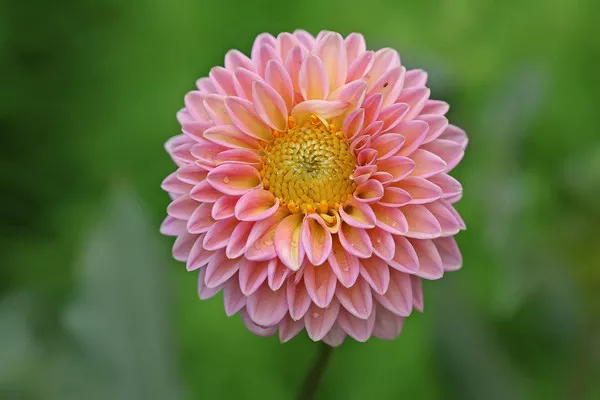Dahlias, with their stunning array of colors and intricate petal formations, have long been cherished in gardens and floral arrangements. Gardening enthusiasts and flower lovers alike are drawn to the vibrant blooms that dahlias offer. However, one question often lingers in the minds of those who cultivate these beautiful flowers: How long do dahlias flower for?
The Dynamic Life Cycle of Dahlias
Dahlias, known for their diversity in size, shape, and color, follow a dynamic life cycle that encompasses various stages from planting to blooming. Understanding these stages is crucial for enthusiasts looking to maximize the longevity of dahlia blooms.
Planting and Germination (0-14 Days)
The journey of a dahlia begins with the planting of its tubers. Typically planted in spring after the last frost, dahlias take around two weeks to germinate. Adequate soil moisture and a well-drained planting site are essential during this phase.
Vegetative Growth (14-60 Days)
As the dahlias emerge from the soil, they undergo a period of vegetative growth. During this phase, the plant focuses on developing strong stems and lush foliage. Adequate sunlight, water, and fertilization play crucial roles in promoting healthy vegetative growth.
Bud Formation (60-75 Days)
Around the 60th day, the focus shifts from foliage to the formation of buds. Dahlias develop buds at the tips of their stems, and these buds hold the promise of the breathtaking blooms to come. This stage is marked by anticipation as gardeners eagerly await the colorful spectacle that dahlias are renowned for.
Blooming Stage (75-120 Days)
The blooming stage is the highlight of the dahlia’s life cycle. Depending on the dahlia variety, blooming typically occurs between 75 to 120 days after planting. The duration of the blooming period can vary based on factors such as climate, care practices, and the specific dahlia cultivar.
Factors Influencing Dahlia Bloom Duration
Several factors contribute to the length of time dahlias bloom, and understanding these variables can empower gardeners to extend the flowering season.
Climate and Growing Conditions
Dahlias thrive in warm climates, and the growing conditions play a significant role in determining their bloom duration. Adequate sunlight, well-drained soil, and a consistent watering schedule contribute to healthy plants and prolonged blooming periods.
Dahlia Varieties
The world of dahlias is rich with diversity, boasting numerous varieties with distinct characteristics. Some dahlias are early bloomers, gracing gardens with their presence sooner, while others take their time to unfold. Exploring different dahlia varieties allows gardeners to curate a garden with blooms throughout the growing season.
Soil Quality and Fertilization
The soil in which dahlias are planted plays a crucial role in their overall health and bloom duration. Well-amended soil with organic matter provides essential nutrients, promoting robust growth and abundant blooms. Regular fertilization, tailored to the specific needs of dahlias, further enhances their flowering potential.
Pruning and Deadheading
Pruning and deadheading are essential practices for prolonging the blooming period of dahlias. Removing spent flowers encourages the plant to redirect energy into producing new blooms. Additionally, strategic pruning can help maintain a compact and bushy plant, ensuring a continuous display of flowers.
Pest and Disease Management
Pests and diseases can significantly impact the health of dahlias, potentially shortening their blooming period. Implementing effective pest management practices and promptly addressing signs of disease can safeguard the plants and contribute to an extended flowering season.
Tips for Prolonging Dahlia Blooms
Gardeners eager to enjoy an extended display of dahlia blooms can employ several tips and tricks to maximize the flowering season.
Successive Planting
To stagger the blooming period, consider successive planting. This involves planting dahlia tubers at different times, creating a sequence of blooms throughout the growing season. This technique allows for a more extended period of dahlia enjoyment.
Mulching
Applying a layer of mulch around dahlia plants serves multiple purposes. Mulch helps retain soil moisture, regulates soil temperature, and suppresses weeds. By creating optimal growing conditions, mulching contributes to healthier plants and potentially prolongs the blooming period.
Regular Maintenance and Care
Consistent and attentive care is paramount for extending the lifespan of dahlia blooms. Regular watering, fertilization, and pest management contribute to overall plant health. Moreover, deadheading spent flowers and removing damaged or diseased foliage promote continuous blooming.
Overwintering Tubers
Dahlias are susceptible to frost, which can damage their tubers. To ensure the longevity of your dahlias, consider overwintering the tubers. Lift them from the ground after the first frost, allow them to dry, and store them in a cool, dry place until the next planting season.
Conclusion
In the realm of gardening, dahlias stand out as captivating performers, gracing landscapes with their vibrant hues and intricate blooms. Understanding the life cycle of dahlias, the factors influencing their bloom duration, and implementing proactive measures can contribute to a more extended and rewarding display of these exquisite flowers.


